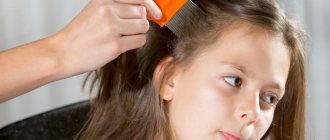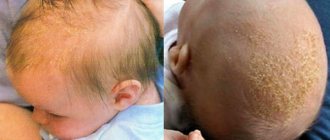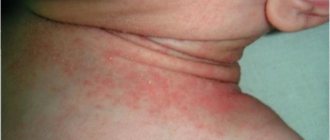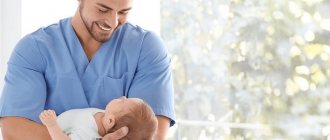Causes (etiology) of diabetes in infants:
Unfortunately, at the moment there is no information about the exact cause of seborrheic dermatitis, but several risk factors for its development can be identified:
- colonization of the skin by yeast fungi of the genus Malassezia;
- increased secretion of sebaceous secretions (oily skin);
- immunodeficiency conditions (HIV, patients after transplantations, etc.);
- heredity (history of the disease in close relatives);
- unfavorable climate (spring-autumn exacerbations are typical).
When to see a doctor
It is important for parents to understand what signs indicate that they need to see a doctor, these include:
- the steps taken at home to remove seborrheic crusts are ineffective, that is, even if the correct procedures are followed, the crusts do not go away within 30 days;
- the baby’s skin itches, turns red and becomes hot - all this indicates the existence of an infection;
- hair begins to fall out;
- seborrheic dermatitis covers not only the head, but also the face and torso;
- the child is very capricious, itches, and becomes very nervous;
- the crusts get wet, and if you try to remove them, wounds form.
These signs may indicate the presence of some kind of fungal infection, which could result from the penetration of streptococci and staphylococci into wounds on the skin.
Symptoms of seborrheic dermatitis
Childhood diabetes is characterized by gradual development and diffuse rashes in certain places - most often on the scalp (including along the hairline), on the face (in the area of the nasolabial folds and along the eyebrows), and also under the diaper.
Based on skin manifestations, seborrheic dermatitis is divided into several types:
- Oily type - the appearance of oily crusts on the scalp, and the appearance of acne on the face is also possible.
- Dry type - the appearance of dandruff on the head, as well as cracks in the area behind the ear.
- Mixed type - manifestations of both types are observed.
In infants, DM often develops in the oily type - in the form of a lesion on the scalp, covered with a thick yellow crust (gneiss, “baby cap” or “milk crust”) and the appearance of yellow flaky scales of characteristic localization (see above). In addition, another type of rash can also be detected on the skin of the face - clearly defined pink-red plaques covered with whitish scales. The same rash can be observed in the diaper area.
What contributes to the growth of crusts
Although the process of crust formation is considered a natural process, as a result of improper manipulations by some parents, crusts can grow.
Causes:
- overheating of the child. Some mothers are so afraid of their baby catching a cold that they put a hat on him even in warm weather and, when this is not required, as a result of sweat, the crusts grow even more;
- frequent washing of the hair deprives the baby of the protective layer of skin, which also helps the crusts to grow;
- the use of bathing products that are not appropriate for the child, which causes allergies and increased formation of crusts;
- the baby's mother eating foods that cause allergies, or feeding the baby formulas that also cause allergies.
Differential diagnosis of diabetes and other dermatological diseases
Diagnosis of seborrheic dermatitis is based on the clinical picture and includes assessment of the nature of the rash (color, shape, and other properties), its location and symmetry. Sometimes it is necessary to use microbiological diagnostics if there is a suspicion of an initially infectious nature of the rash or the addition of a secondary bacterial/fungal infection.
The difficulty in diagnosing seborrheic dermatitis lies in making a correct differential diagnosis with other clinically similar dermatological diseases, because psoriasis, atopic dermatitis, lichen planus, and rosacea (rosacea).
Is treatment necessary?
The crusts on a baby's head are absolutely harmless in themselves, but they have an unsightly and unkempt appearance. For this reason, you want to remove them so that the child looks neat. But first you need to make sure that they really do not pose a danger. If you manage to separate the scale from the head, you need to check if there is a red spot left. The absence of a stain is a good sign.
In most cases, crusts on a baby’s head disappear on their own by 9-12 months, without the use of any procedures.
However, in cases of severe cases of the disease, the doctor gives recommendations on what shampoo or lotion to use to get rid of such crusts.
Treatment and care for seborrheic crusts in children
Seborrheic dermatitis may resolve without treatment, but relapses are common after periods without clinical manifestations. If treatment is still necessary, then to correctly prescribe it, you need to contact a specialist - a pediatric dermatologist.
Often the basis of treatment is the selection of special medicinal cosmetics: shampoos, lotions and creams that can gently cleanse the scalp of crusts and remove excess sebaceous secretions from the facial skin. In addition, for children it is important to select products that can relieve itching, because... additional scratching of the rash can lead to secondary infections.
For treatment, products are used that contain the following components:
- keratolytics (eg salicylic and lactic acids) - to soften the top layer of skin;
- antifungal agents - when mycoses are attached;
- local corticosteroids - to relieve inflammation;
- in severe cases, phototherapy and the use of isotretinoin to reduce seborrhea are justified.
Skin care for children with diabetes should be regular (daily) to improve the course of the disease and speed up recovery. Children's cosmetics for skin care with diabetes are classified as medicinal products and therefore are selected only by a specialist (pediatric dermatologist). Care includes the following procedures:
- Applying baby cosmetic oil before washing your hair to soften seborrheic crusts.
- Wash your hair with a special shampoo using gentle massaging movements to avoid skin trauma.
- Daily treatment of rashes on the face, along the hairline and in the area behind the ear with a special cream or lotion.
- Thoroughly dry the skin after hygiene procedures to prevent the appearance of a damp environment favorable for the development of microorganisms.
Crusts on a child’s head: reasons for their appearance
The reasons for the appearance of seborrheic dermatitis (gneiss) on the heads and behind the ears of newborn babies have not yet been fully established. However, most pediatricians associate the occurrence of “milk crusts” with:
diseases of the maternal gastrointestinal tract during gestation;- lack of vitamins and unsaturated fatty acids;
- abuse during pregnancy of products containing obligate allergens (chocolate, nuts, citrus fruits, honey, etc.);
- as well as the immaturity of the baby’s sweat and sebaceous glands;
- too delicate skin in infants;
- and increased sebum production in some cases.
It happens that gneiss occurs as a reaction to a specific allergen. Or during treatment with antibiotics. Crusts can also occur if a nursing mother has eaten a lot of sweets. In these cases, the baby’s condition worsens: redness and peeling “spread” to the face, neck, and ears. The child becomes restless, begins to spit up frequently, and, in addition, he may develop diarrhea.
What not to do
It is important for young parents to understand what actions should not be performed so as not to cause stagnation in the fight against seborrheic dermatitis:
- Scrape off milky crusts with nails, combs or any other objects that can injure delicate baby skin, especially on the crown of the head. Such actions can lead to the penetration of pathogenic bacteria.
- Carrying out the procedure to get rid of crusts on a baby’s head too often. The recommended interval is 5-6 days.
- Dry and rub your hair; instead, it is recommended to use a soft towel to blot your head.
- Feed your child fatty foods.
Opinion of Dr. E.V. Komarovsky
According to a well-known children's doctor, crusts on a baby's head, although they have an unsightly appearance, do not cause any additional inconvenience to the baby. This is an absolutely natural physiological phenomenon . During its normal course, the crusts do not hurt or itch.
These unsightly scales practically do not bother the child; the baby begins to worry only because of the strange behavior of the parents. Seborrheic dermatitis is not a contagious disease and does not mean that the mother does not care for the baby carefully enough.
In this regard, Evgeniy Olegovich’s main recommendations for caring for seborrheic crusts are the following:
- get rid of concerns about the appearance of crusts on the baby’s head, most often they will go away on their own;
- if the parents nevertheless decide to remove the scales, they must first be softened with vegetable oil;
- Gently comb them out with a blunt-tooth comb.
Dr. Komarovsky convincingly asks to leave children with long hair alone. Seborrheic crusts do not pose a particular danger to the baby, but the manipulations that the mother will carry out can cause him discomfort and sad memories.
Unfortunately, milk crusts may appear again after actively fighting them.
To prevent this from happening, Evgeniy Olegovich gives the following recommendations:
- Maintain optimal air humidity in the room where the baby lives - 50-70%. A humidifier will be a useful purchase. Correctly configured options will allow you to maintain the desired air humidity.
- The air temperature in the child's room should not be higher than 22°C, the most suitable is 18-19°C.
- You should not wash your child's hair with soap. Even baby soap, or hypoallergenic soap, dries out delicate skin and thereby stimulates the sebaceous glands to work harder, resulting in crusts forming again.
- When breastfeeding, the mother should follow a hypoallergenic diet. In the case of artificial feeding, you should choose gluten- and milk-free cereals.
- Use natural products for washing, bathing and caring for the baby, as well as products for washing children's clothes.
- Bath your baby daily before bed, and only 2 times a week using appropriate soap or shampoo.
- Remember the main rule of caring for your baby: it is better to overcool than to overheat. The main helpers in maintaining the correct temperature are: suitable clothing, a sufficient amount of liquid that the child consumes, and a bath.
In their natural manifestation on the baby’s head, the crusts in no way threaten the baby’s health, but still, if the parents still have doubts, and the area of the skin covered with seborrheic crusts increases, scales also appear on the face, neck, and groin area, then you need to contact your pediatrician.
Author of the article: Kira Kuznetsova
Article design: Svetlana Ovsyanikova










